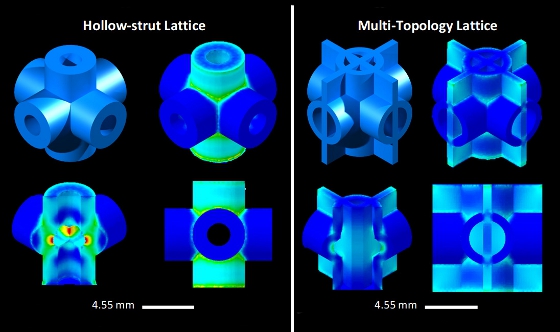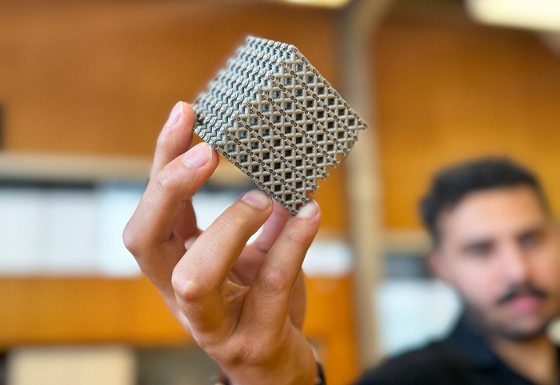3D-printed titanium structure has supernatural strength Posted on 27 Feb 13:27
PhD candidate Jordan Noronha holding a sample of the new titanium lattice structure 3D printed in cube form. [Credit: RMIT]
By Michael Quin, RMIT University
A 3D-printed "metamaterial" boasting levels of strength for weight not normally seen in nature or manufacturing could change how we make everything from medical implants to aircraft or rocket parts.
RMIT University researchers in Melbourne, Australia, created the new metamaterial -- a term used to describe an artificial material with unique properties not observed in nature -- from common titanium alloy.
However, it's the material's unique lattice structure design, recently revealed in the Advanced Materials journal, that makes it anything but common: Tests show it is 50% stronger than the next strongest alloy of similar density used in aerospace applications. Interestingly, the initial lattice shape was inspired by corals.
In their paper, the researchers list potential applications as: "in demanding thermal protection systems such as those for hypersonic vehicles," "titanium drones used to monitor or fight bushfires or severe industrial fires at close range and with extended flight times," or "as implant materials, as well as lightweight structures to replace magnesium alloy components in defense and aerospace (being lighter, stronger, and more heat and corrosion resistant)."
Improving nature's own design
Lattice structures made from hollow struts were originally inspired by nature: strong hollow-stemmed plants like the Victoria water lily or the hardy organ pipe coral (Tubipora musica) showed the way in combining lightness and strength.
However, as RMIT's Distinguished Professor Ma Qian explained, decades of trying to replicate these hollow "cellular structures" in metals has been frustrated by the common issues of manufacturability and load stress concentrating on the inside areas of the hollow struts, leading to premature failures.
"Ideally, the stress in all complex cellular materials should be evenly spread," Qian said. "However, for most topologies, it is common for less than half of the material to mainly bear the compressive load, while the larger volume of material is structurally insignificant."
Metal 3D printing provides unprecedented innovative solutions to these issues.
By pushing 3D printing design to its limits, the RMIT team optimized a new type of lattice structure to distribute the stress more evenly, enhancing its strength or structural efficiency.
"We designed a hollow tubular lattice structure that has a thin band running inside it. These two elements together show strength and lightness never before seen together in nature," said Qian. "By effectively merging two complementary lattice structures to evenly distribute stress, we avoid the weak points where stress normally concentrates."

Compression testing shows (left) stress concentrations in red and yellow on the hollow strut lattice, while (right) the double lattice structure spreads stress more evenly to avoid hot spots. [Credit: RMIT]
Laser-powered strength
They 3D printed this design at RMIT's Advanced Manufacturing Precinct using a process called laser powder bed fusion, where layers of metal powder are melted into place using a high-powered laser beam.
Testing showed the printed design -- a titanium (Ti-6Al-4V TP-HSL) lattice cube -- was 50% stronger than cast magnesium alloy WE54, the strongest alloy of similar density used in aerospace applications. The new structure had effectively halved the amount of stress concentrated on the lattice's infamous weak points.
The double lattice design also means any cracks are deflected along the structure, further enhancing the toughness.
Study lead author and RMIT PhD candidate Jordan Noronha said they could make this structure at the scale of several millimeters or several meters in size using different types of printers.
This printability, along with the strength, biocompatibility, corrosion, and heat resistance, make it a promising candidate for many applications from medical devices such as bone implants to aircraft or rocket parts.
"Compared with the strongest available cast magnesium alloy currently used in commercial applications requiring high strength and light weight, our titanium metamaterial with a comparable density was shown to be much stronger or less susceptible to permanent shape change under compressive loading, not to mention more feasible to manufacture," Noronha said.
The team plans to further refine the material for maximum efficiency and explore applications in higher-temperature environments.
While currently resistant to temperatures as high as 350 °C, they believe it could be made to withstand temperatures up to 600 °C using more heat-resistant titanium alloys for applications in aerospace or firefighting drones.
As the technology to make this new material is not yet widely available, its adoption by industry might take some time.
"Traditional manufacturing processes are not practical for the fabrication of these intricate metal metamaterials, and not everyone has a laser powder bed fusion machine in their warehouse," he said. "However, as the technology develops, it will become more accessible and the printing process will become much faster, enabling a larger audience to implement our high-strength multi-topology metamaterials in their components. Importantly, metal 3D printing allows easy net shape fabrication for real applications."
Technical Director of RMIT's Advanced Manufacturing Precinct, Distinguished Professor Milan Brandt, said the team welcomed companies wanting to collaborate on the many potential applications. "Our approach is to identify challenges and create opportunities through collaborative design, knowledge exchange, work-based learning, critical problem solving, and translation of research," he said.
Published February 2024

